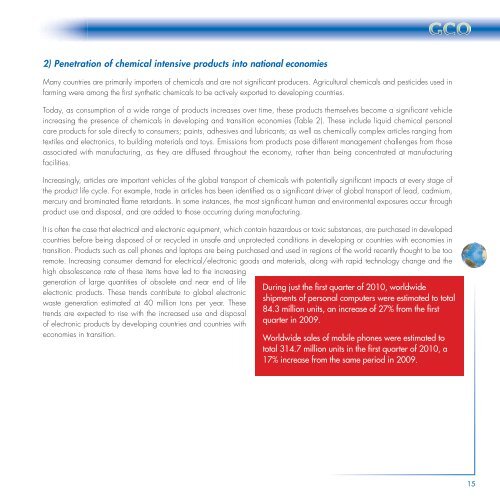Global Chemicals Outlook - UNEP
Global Chemicals Outlook - UNEP
Global Chemicals Outlook - UNEP
You also want an ePaper? Increase the reach of your titles
YUMPU automatically turns print PDFs into web optimized ePapers that Google loves.
2) Penetration of chemical intensive products into national economies<br />
Many countries are primarily importers of chemicals and are not signifi cant producers. Agricultural chemicals and pesticides used in<br />
farming were among the fi rst synthetic chemicals to be actively exported to developing countries.<br />
Today, as consumption of a wide range of products increases over time, these products themselves become a signifi cant vehicle<br />
increasing the presence of chemicals in developing and transition economies (Table 2). These include liquid chemical personal<br />
care products for sale directly to consumers; paints, adhesives and lubricants; as well as chemically complex articles ranging from<br />
textiles and electronics, to building materials and toys. Emissions from products pose different management challenges from those<br />
associated with manufacturing, as they are diffused throughout the economy, rather than being concentrated at manufacturing<br />
facilities.<br />
Increasingly, articles are important vehicles of the global transport of chemicals with potentially signifi cant impacts at every stage of<br />
the product life cycle. For example, trade in articles has been identifi ed as a signifi cant driver of global transport of lead, cadmium,<br />
mercury and brominated fl ame retardants. In some instances, the most signifi cant human and environmental exposures occur through<br />
product use and disposal, and are added to those occurring during manufacturing.<br />
It is often the case that electrical and electronic equipment, which contain hazardous or toxic substances, are purchased in developed<br />
countries before being disposed of or recycled in unsafe and unprotected conditions in developing or countries with economies in<br />
transition. Products such as cell phones and laptops are being purchased and used in regions of the world recently thought to be too<br />
remote. Increasing consumer demand for electrical/electronic goods and materials, along with rapid technology change and the<br />
high obsolescence rate of these items have led to the increasing<br />
generation of large quantities of obsolete and near end of life<br />
electronic products. These trends contribute to global electronic<br />
waste generation estimated at 40 million tons per year. These<br />
trends are expected to rise with the increased use and disposal<br />
of electronic products by developing countries and countries with<br />
economies in transition.<br />
During just the fi rst quarter of 2010, worldwide<br />
shipments of personal computers were estimated to total<br />
84.3 million units, an increase of 27% from the fi rst<br />
quarter in 2009.<br />
Worldwide sales of mobile phones were estimated to<br />
total 314.7 million units in the fi rst quarter of 2010, a<br />
17% increase from the same period in 2009.<br />
15

















